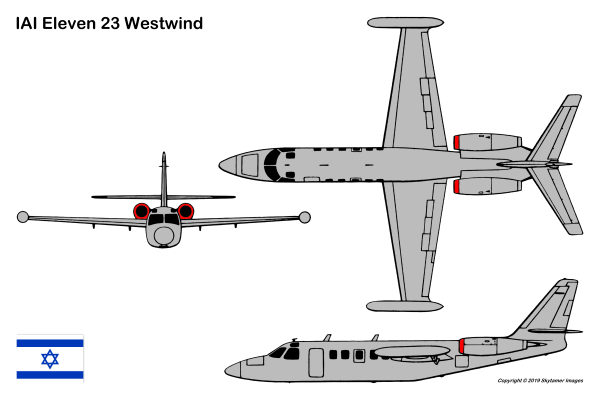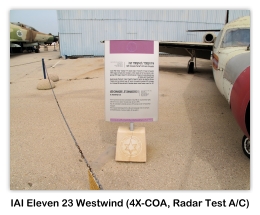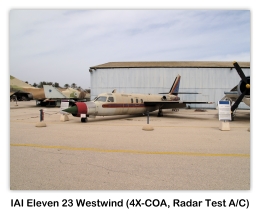

























IAI Eleven 23 Westwind
Israeli Air Force VIP/Research Aircraft
Archive Photos 1

Archive Photos 1
IAI Eleven 23 Westwind (IAI Lavi radar testbed), (4X-COA, c/n 71) on display at the Israeli Air Force Museum, Be’er Sheba, Israel on 3/5/2009



Overview 2,3
- IAI 1123 Westwind
- Role: Business jet
- Manufacturer: Israel Aircraft Industries
- First flight (prototype): 28 September 1970
- Introduction; 1972
- Developed from: Aero Commander 1121 Jet Commander
- Variants: IAI Astra
The Israel Aircraft Industries (IAI) Westwind (formerly Aero Commander 1121 Jet Commander) is a business jet that became a cornerstone of the Israeli aircraft manufacturing industry and remained in production for 20 years. Usually configured for seven passengers, it can carry as many as 10, or be quickly reconfigured as a fast air freight aircraft.
Design and Development 2
The Westwind was originally designed in the United States by Aero Commander as a development of its twin-propeller namesake aircraft, first flying on January 27, 1963 as the Aero Commander 1121 Jet Commander. It was of broadly conventional business jet arrangement, with two engines mounted in nacelles carried on the rear fuselage. However the wings were mounted halfway up the fuselage instead of the typical low-wing arrangement of aircraft in this class. After successful testing, the aircraft was put into series production with deliveries to customers beginning in early 1965.
After initial testing of the prototype it was modified to production standard with an addition 2 ft 6 in to the fuselage length and increased payload and maximum weights. The second prototype first flew on 14 April 1964 which was followed by the first production aircraft in November 1964. Type approval was awarded by the FAA in November enabling the first customer delivery on 11 January 1965.
Operational History 2
Shortly thereafter, Aero Commander was acquired by North American Rockwell. The Jet Commander created a problem, since Rockwell already had an executive jet of its own design, the Sabreliner, and could not keep both in production because of anti-trust laws. Therefore, the company decided to sell off the rights to the Jet Commander, which were purchased by IAI in 1968.
Jet Commander production amounted to 150 aircraft in the United States and Israel before IAI undertook a series of modifications to create the 1123 Westwind. These included stretching the fuselage and increased maximum takeoff, maximum landing, and maximum zero-fuel weights, with the wing modified to incorporate double-slotted flaps and drooped leading edges and tip tanks. The trimmable horizontal stabilizer was also modified to have increased span and more travel. Not long after the aircraft went into production, the original General Electric CJ610 turbojet engines were replaced by more fuel-efficient Garrett TFE731 turbofans. There were also numerous airframe modifications, such as drooped leading edges on the wings, a dorsal fin, revised engine pylons and nacelles, and further increases in maximum takeoff, maximum landing, and maximum zero-fuel weights. With improvements to a number of onboard systems incorporated as well, these changes resulted in the 1124 Westwind delivered from 1976.
In 1976, in the wake of the terrorist takeover of the Savoy hotel in Tel Aviv, the Israeli Air Force decided to use the Westwind as the basis for a maritime patrol aircraft, which became known as the IAI Sea Scan. It had originally been developed to meet a requirement for the United States Coast Guard to replace the Grumman HU-16 Albatross. The Dassault Falcon was selected instead.
In 1980, deliveries of the Model 1124A commenced; modifications included a new wing center-section and the addition of winglets to the tips. The revamped aircraft was called the Westwind II, replacing the original design in production. IAI built its last Westwind in 1987, after a total of 442 Jet Commanders and Westwinds had been built, switching production to the Astra.
Variants 2
Aero Commander
- 1121 Jet Commander: Original production version, powered by two General Electric CJ610-1 engines developing 2,850 lbf (12,700 N) each; or modified with two CJ610-5 engines developing 2,950 lbf (13,100 N) each. A total of 120 were built including two prototypes.
- 1121A: Approved in 1967 the 1121A had overwing refueling points with integral fuel tanks, new wheels, tires and brakes, improved cockpit lighting, maximum ceiling increased to 45,000 ft and all-up weigh to 17,500 lbs, kept the CJ610-1 engines; 11 built.
- 1121B Commodore: Version manufactured with CJ610-5 engines; 19 built.
- 1121C: Unofficial designation for 1121 aircraft modified under a Supplemental Type Certificate with an increased all-up weight available from 1971.
- 1122: Improved version developed but not put into production; two aircraft built and subsequently converted to 1123 Westwinds.
IAI
- 1123 Westwind: Improved version of the 1121. The cabin was stretched by 0.51 m (1 ft 8 in) and the aircraft was fitted with more powerful CJ610-9 engines developing 3,100 lbf (14,000 N) each and a Microturbo Saphir III auxiliary power unit (APU). 36 built.
- 1124 Westwind; Greatly improved version powered by two Garrett TFE731-3-1G turbofan engines developing 3,700 lbf (16,000 N) each, APU deleted.
- 1124 Westwind I: Name given to 1124 after introduction of Westwind II.
- 1124N Sea Scan: Maritime surveillance aircraft.
- 1124A Westwind II: Refined version of the 1124 built from 1980 onwards.
Operators 2
Civil Operators
- Australia: Pel-Air: Six of which four are in aero-medical configuration.
- Canada: Royal Canadian Mounted Police; Discovery Air Defence
- United States: North Country Aviation, Gaylord, MI. Chartered; FAA Federal Aviation Administration; Corporate Flight Management
- Fiji: Helipro Fiji: One aircraft in aero-medical configuration.
Military Operators
- Chile: Chilean Navy
- Ecuador: Ecuadorian Air Force
- Honduras: Honduran Air Force - one 1123 operated during 1976.
- Israel: Israeli Air Force
- Mexico: Mexican Air Force: Inactive
- Panama: Panamanian Air Force - one 1123 delivered in 1975.
- Uganda: Ugandan Air Force - one 1121N operated from 1971 to 1976 as a presidential aircraft.
- United States: United States Coast Guard - one 1123 leased in 1973 for evaluation.
Specifications IAI Eleven 23 Westwind 2
Type
- Twin jet light executive transport.
Wings
- Cantilever mid-wing monoplane.
- Wing section NACA 64A212.
- Dihedral 2°.
- Incidence 1° at root, 1° at tip.
- Sweepback: 4° 37’ at quarter-chord.
- All-metal flush. riveted two-spar failsafe structure.
- Manually. operated all-metal ailerons.
- Electrically operated all-metal double slotted trailing edge.
- Fowler type flaps and detachable drooped leading edge.
- Electrically operated trim tab in port aileron.
- Hydraulically actuated speed brake and two lift dumpers above each wing, forward of flap.
- All skins chemically milled and fully sealed.
- All primary control surfaces, including tabs, are fully mass balanced.
- Pneumatic anti-icing boots standard.
Fuselage
- All metal semi-monocoque flush-riveted structure with pressurized failsafe cabin and baggage compartment.
- Built in two main sections and joined at aft pressure bulkhead.
- Forward section, except for nose cone, is fully pressurized.
Tail Unit
- Cantilever all-metal structure, with 28° sweepback at quarter-chord.
- Variable-incidence tailplane, actuated electrically.
- Manually-operated statically-balanced elevators and rudder.
- Trim tab in rudder.
- Pneumatic anti-icing boots standard.
Landing Gear
- Hydraulically-retractable tricycle type, main wheels retracting outward into wings, twin nosewheels rearward.
- Oleo-pneumatic shock·absorbers.
- Single wheel on each main unit, pressure 155 1b/in2 (10.9 kg/cm²).
- Nose unit steerable and self-centering.
- Nosewheel tire pressure 50 lb/in2 (3.5 kg/cm²).
- Goodyear multiple-disc brakes.
- Fully-modulated anti-skid system has automatic computer/sensor to prevent wheel lock and maintain brake effectiveness.
- Parking brake fitted.
Power Plant
- Two 3,100 1b (1,406 kg) st General Electric CJ610·9 turbojet engines, mounted in pod on each side of rear fuselage.
- 85% of wing area forms an integral fuel tank, and additional fuel is carried separately in wingtip tanks and rear fuselage tanks.
- Total usable capacity 1,107 Imp gallons (1,330 US gallons; 5,035 liters), including wingtip tanks.
- Refuelling points in wingtips and fuselage.
Accommodation
- Standard seating for two pilots and up to 10 passengers in pressurized cabin.
- Interior layout to customer’s requirements, with galley and toilet standard.
- Separate pressurized compartment for up to 400 lb (l81 kg) of baggage.
- Passenger door at front on portside, and two emergency exits.
- Entire accommodation heated, ventilated and air-conditioned.
Systems
- Primary hydraulic system, pressure 2,000 lb/in2 (140 kg/cm²), operates through two engine-driven pumps to actuate landing gear, wheel brakes, nosewheel steering, speed brakes and lift dumpers.
- Electrically-operated emergency system, pressure 1,000 lb/in2 (70 kg/cm²), for brakes only.
- DC electrical system with two 350A 24V engine-driven starter-generators and two 21Ah long-life nickel-cadmium batteries.
- One main bus for each generator, connected to the central battery bus.
- A 400 Hz 115V AC system is installed, and is powered by two solid-state static inverters, each of 1,000 VA capacity, with power fed from the main DC buses.
- Each inverter is independently capable of supplying the entire AC load if required.
- Pneumatic system for anti-icing of wing and tail leading-edges only.
- Warm air bled from engines to prevent icing of air intakes.
- Wind-shield is heated electrically.
- Microturbo Saphir III APU, installed in tailcone, for ground air-conditioning and ground electrical power supply.
- Cabin air pressure max differential of 8.7 lb/in2 (0.61 kg/cm²) up to 45,000 ft (13,715 m).
Equipment
- Full blind-flying instrumentation standard.
- Radio and avionics to customer’s requirements.
Dimensions, External
- Wing span: 44 ft 9½ in (13.65 m)
- Wing chord at root: 10 ft 6 in (3.20 m)
- Wing chord at tip: 3 ft 6 in (1.07 m)
- Wing aspect ratio: 6.51
- Length overall: 52 ft 3 in (15.93 m)
- Fuselage max width: 5 ft 2 in (1.57 m)
- Fuselage max depth: 6 ft O in (1.83 m)
- Height overall: 15 ft 9 in (4.81 m)
- Tailplane span: 21 ft 0 in (6.40 m)
- Wheel track: 11 ft 0 in (3.35 m)
- Passenger door height: 4 ft 6 in (1.37 m)
- Passenger door width: 2 ft 0 in (0.61 m)
- Passenger door height to sill: 1 ft 8 in (0.51 m)
Dimensions, Internal (Cabin, excluding flight deck)
- Length: 15 ft 6 in (4.72 m)
- Max width: 4 ft 9 in (1.45 m)
- Max height: 4 ft 11 in (1.50 m)
- Volume: 347 ft3 (9.83 m3)
- Baggage compartment volume: 25 ft3 (0.71 m3)
Areas
- Wings, gross: 308.26 ft² (2864 m²)
- Ailerons (total): 15.39 ft² (1.43 m²)
- Trailing-edge flaps (total): 41.58 ft² (3.86 m²)
- Fin: 48.60 ft² (4.51 m²)
- Rudder, including tab: 10.69 ft² (0.99 m²)
- Tailplane: 52.42 ft² (4.87 m²)
- Elevators: 17.66 ft² (1.64 m²)
Weights and Loading
- Weight empty, equipped: 9,370 lb (4,250 kg)
- Typical basic operating weight: 11,300 lb (5,125 kg)
- Max payload: 2,200 lb (1,000 kg)
- Max T-O weight: 20,500 lb (9,298 kg)
- Max ramp weight: 20,800 1b (9,434 kg)
- Max zero-fuel weight: 13,500 lb (6,123 kg)
- Max landing weight 19,000 lb (8,618 kg)
- Max cabin floor loading: 200 lb/ft² (976.5 kg/m²)
Performance (at max T-O weight, ISA, except where indicated)
- Max operating speed at S/L: 360 knots (415 mph; 668 km/h) CAS
- Max operating speed at 18,000 ft (5,485 m): 372 knots (428 mph; 689 km/h) CAS
- Max true air speed at 18,000 ft (5,485 m): 471 knots (542 mph; 872 km/h) TAS
- Max operating Mach number at 18,000 ft (5,485 m) and above: Mach 0.765
- Econ cruising speed at 41,000 ft (12,500 m): 365 knots (420 mph; 676 km/h)
- Stalling speed, flaps and landing gear down, at max landing weight: 97 knots (112 mph; 180 km/h) CAS
- Stalling speed, flaps and landing gear down, at 12,000 lb (5,443 kg) AUW: 79 knots (91 mph; 146·5 km/h) CAS
- Max rate of climb at S/L: 4,040 ft/min (1,231 m/min)
- Rate of climb at S/L, one engine out: 1,100 ft/min (335 m/min)
- Service ceiling: 45,000 ft (13,715 m)
- Service ceiling, one engine out: 22,500 ft (6,860 m)
- T-O to 35 ft (10.7 m): 4,100 ft (1,250 m)
- FAA balanced T-0 field length: 5,350 ft (1,631 m)
- Balanced field length at 18,000 lb (8,164 kg) AUW: 3,800 ft (1,158 m)
- Landing from 50 ft (15 m) at max landing weight: 3,400 ft (1,036 m)
- Landing from 50 ft (15 m) at 14,000 lb (6,350 kg) AUW: 2,650 ft (808 m)
- Range with max fuel, 5 passengers and baggage, 45 min reserve: 1,840 nm (2,120 miles; 3,410 km)
- Range with max payload, 45 min reserve: 1,390 nm (1,600 miles; 2,575 km)
- IFR range with 6 passengers after T-O from balanced field length of 4,000 ft (1,220 m): 1,233 nm (1,420 miles; 2,285 km)
References
- Shupek, John. The Skytamer Archive, Israeli Air Force Museum, copyright © 3/5/2009
- Wikipedia, the free encyclopedia. IAI Westwind
- Taylor, John. Jane’s All the World’s Aircraft 1972-73, IAI Commodore Jet Eleven 23, McGraw-Hill Book Company, New York, 1972, ISBN 07 032162-0, pg 113-114.



































































